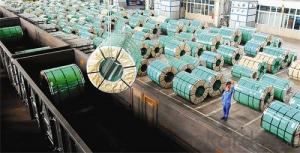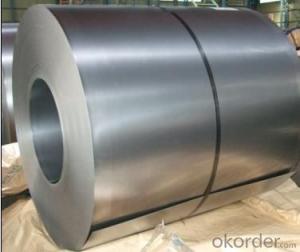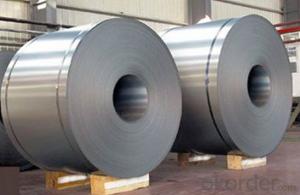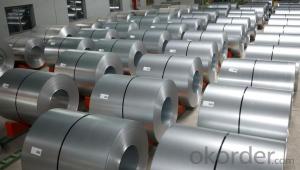Stainless Steel Sheet 304 Cold Rolled 2B Finish
- Loading Port:
- Ningbo
- Payment Terms:
- TT OR LC
- Min Order Qty:
- 100 m.t.
- Supply Capability:
- 20000 m.t./month
OKorder Service Pledge
Quality Product, Order Online Tracking, Timely Delivery
OKorder Financial Service
Credit Rating, Credit Services, Credit Purchasing
You Might Also Like
Cold Rolled Stainless Steel Coil 304 Grade 2B Finish
Packaging Detail: standard export packing or as customer's requirements
Delivery Detail: 7-15 days after the order
Standard: | AISI,ASTM,BS,DIN,GB,JIS | Grade: | 304 | Thickness: | 0.3-3.0mm |
Place of Origin: | China Mainland | Brand Name: | CNBM | Model Number: | 304 |
Type: | Steel Coil | Technique: | Cold Rolled | Surface Treatment: | 2B, BA |
Application: | Medical instruments, building, chemical food industry agriculture | Width: | 500-2000mm | Length: | Coil |
finish: | 2B, BA | item: | 304 cold rolled stainless steel coil | density: | 7.93 |
- Q:How do stainless steel strips handle exposure to solvents?
- Stainless steel strips are known for their excellent resistance to solvents. They are highly durable and can withstand exposure to various solvents without significant damage or corrosion. The composition of stainless steel, which includes a high percentage of chromium, provides a protective layer called chromium oxide. This layer acts as a shield against solvents, preventing them from penetrating the steel surface and causing any adverse effects. Furthermore, stainless steel strips have low reactivity with solvents, making them suitable for use in environments where exposure to chemicals is common. They are resistant to many organic solvents, such as alcohols, acetone, and hydrocarbons, as well as some inorganic solvents like acids and bases. It is important to note that while stainless steel strips generally have excellent resistance to solvents, their performance may vary depending on the specific type and concentration of the solvent, as well as the duration of exposure. In some cases, prolonged exposure to aggressive solvents or high concentrations may lead to slight discoloration or etching on the stainless steel surface. To ensure optimal performance and longevity, it is recommended to choose the appropriate grade of stainless steel for specific solvent applications. Consulting with stainless steel manufacturers or industry experts can provide valuable guidance on selecting the most suitable stainless steel grade for a particular solvent environment. Regular cleaning and maintenance, including wiping off any spilled solvents and avoiding abrasive cleaning agents, can also help preserve the integrity and appearance of stainless steel strips exposed to solvents.
- Q:Can stainless steel strips be used in nuclear power applications?
- Certainly, stainless steel strips are applicable in nuclear power uses. Due to its exceptional resistance to corrosion, high-temperature strength, and low magnetic permeability, stainless steel is highly favored in the nuclear industry. It finds widespread use in reactor components, fuel storage containers, heat exchangers, and piping systems. The versatility of stainless steel strips lies in their ease of being molded into different shapes and sizes, making them ideal for various nuclear power applications. Moreover, stainless steel's capability to endure radiation damage and its limited interaction with nuclear fuel further enhance its suitability for nuclear power uses.
- Q:How do stainless steel strips perform in the presence of sulfuric acid?
- Stainless steel strips generally exhibit good resistance to sulfuric acid under certain conditions. The performance of stainless steel in the presence of sulfuric acid depends on several factors including the concentration and temperature of the acid, the grade of stainless steel, and the duration of exposure. In general, stainless steel is resistant to dilute sulfuric acid solutions (up to 10%) at room temperature. The passive film that naturally forms on the surface of stainless steel provides excellent protection against corrosion in these conditions. The resistance can vary depending on the specific grade of stainless steel, with austenitic stainless steel (such as 304 and 316) offering better corrosion resistance than ferritic or martensitic grades. However, as the concentration of sulfuric acid increases or the temperature rises, the corrosion resistance of stainless steel can be compromised. At higher concentrations (above 10%) or elevated temperatures, stainless steel may experience localized corrosion, including pitting or crevice corrosion. Under such conditions, it is common to use higher alloyed stainless steels, such as duplex or super duplex grades, which offer enhanced resistance to sulfuric acid. It is important to note that prolonged exposure to sulfuric acid can eventually lead to corrosion even in stainless steel. Therefore, it is advisable to limit the exposure time and concentration of the acid to minimize the risk of corrosion. Additionally, proper maintenance and regular cleaning can help maintain the corrosion resistance of stainless steel in the presence of sulfuric acid.
- Q:What are the different surface treatments available for stainless steel strips?
- Stainless steel strips offer a range of surface treatments, each with its own advantages and characteristics. Let's explore some of the most common options: 1. The standard untreated surface of stainless steel strips is called Mill Finish. It has a smooth and shiny appearance, perfect for those who prefer a natural, unaltered look. 2. Another popular treatment is the Brushed Finish, also known as satin finish. This involves brushing the surface with abrasive materials to create a matte texture. It not only adds a stylish touch but also helps to conceal scratches and fingerprints. 3. For a highly reflective surface, there is the Mirror Finish. Achieved through progressive polishing with finer abrasives, it creates a mirror-like appearance. 4. If you're looking for decorative patterns, the Patterned Finish is the way to go. This treatment involves embossing, etching, or laser engraving to achieve various designs and textures. 5. PVD Coating, or Physical Vapor Deposition coating, offers a thin layer of metallic or non-metallic material applied through a vacuum deposition process. This not only provides enhanced durability and corrosion resistance but also allows for different colors or a metallic appearance. 6. Passivation is a chemical treatment that removes iron contaminants from the surface, improving corrosion resistance. It utilizes acid-based solutions to clean and neutralize the stainless steel strips. 7. Electropolishing involves the removal of a thin layer of metal using an electric current. This treatment results in a smooth and shiny surface, enhances corrosion resistance, and eliminates embedded contaminants. 8. Lastly, stainless steel strips can be coated with materials like paint, epoxy, or polymers for additional protection against corrosion, abrasion, or for aesthetic purposes. These examples showcase the diverse range of surface treatments available for stainless steel strips. The choice of treatment depends on specific requirements such as desired appearance, corrosion resistance, durability, and functionality.
- Q:What are stainless steel strips used for?
- Stainless steel strips have a wide range of applications due to their unique properties and versatility. They are commonly used in various industries such as automotive, construction, aerospace, and manufacturing. One of the main uses of stainless steel strips is in the production of kitchen appliances and utensils. The corrosion-resistant nature of stainless steel makes it an ideal material for these applications as it prevents rust and staining, ensuring a longer lifespan for these products. Additionally, stainless steel strips are used in the fabrication of sinks, countertops, and backsplashes, providing a durable and hygienic surface that is easy to clean. In the automotive industry, stainless steel strips find application in the production of exhaust systems, mufflers, and trim components. The high-temperature resistance and corrosion resistance of stainless steel make it a suitable material for these parts, ensuring longevity and performance even in harsh conditions. Stainless steel strips are also used in construction and architecture. They can be found in various structural components, such as beams, columns, and reinforcement bars. The durability and strength of stainless steel make it an ideal choice for these applications, especially in environments where corrosion or weathering is a concern. Another important use of stainless steel strips is in the manufacturing industry. They are used in the fabrication of machinery and equipment, including conveyor belts, springs, and fasteners. The strength, toughness, and resistance to wear and tear make stainless steel strips a reliable choice in these applications. Overall, stainless steel strips are used in a wide range of applications due to their corrosion resistance, durability, strength, and aesthetic appeal. Their versatility allows them to be utilized in various industries, making them an essential material for many products and structures.
- Q:Are 111 stainless steel strips suitable for architectural façades?
- Yes, 111 stainless steel strips are suitable for architectural façades. Stainless steel is a popular choice for architectural applications due to its durability, strength, and corrosion resistance. The grade 111 stainless steel, also known as AISI 304, is a versatile and widely used stainless steel grade that offers excellent resistance to atmospheric and chemical corrosion. Architectural façades require materials that can withstand various environmental factors such as wind, rain, UV exposure, and temperature changes. Stainless steel, including the grade 111, meets these requirements and can provide a long-lasting and aesthetically pleasing solution for façades. In addition to its durability, stainless steel also offers design flexibility. It can be easily formed into different shapes and sizes, allowing for creative and unique architectural designs. The polished or brushed finish of stainless steel can also enhance the appearance of a building, giving it a modern and sleek look. Furthermore, stainless steel is low maintenance, requiring minimal cleaning and upkeep to maintain its appearance. This makes it a cost-effective choice for architectural façades, as it does not require regular painting or coating like other materials. Overall, 111 stainless steel strips are suitable for architectural façades due to their durability, corrosion resistance, design flexibility, and low maintenance.
- Q:Can stainless steel strips be used in the aerospace landing gear?
- Stainless steel strips are capable of being utilized in aerospace landing gear. The utilization of stainless steel in aerospace applications is highly favored due to its exceptional ability to resist corrosion, possess high strength, and exhibit durability. The components of the landing gear are subjected to various environmental conditions and stress loads during takeoff, landing, and taxiing. Therefore, stainless steel is an ideal choice as it can endure these factors. Moreover, stainless steel's resistance to fatigue and impact enables it to withstand the intense loads and shocks encountered during landing and ground operations. Additionally, its high strength-to-weight ratio allows for reduced weight, which is of utmost importance in aerospace applications where weight optimization is a priority. In conclusion, employing stainless steel strips in aerospace landing gear provides a dependable and long-lasting solution.
- Q:Can stainless steel strips be painted or coated?
- Yes, stainless steel strips can be painted or coated.
- Q:What are the common sizes and dimensions of stainless steel strips?
- The specific application and industry requirements play a role in determining the common sizes and dimensions of stainless steel strips. However, the market does offer standard sizes and dimensions. For instance, one frequently encountered size of stainless steel strips measures 0.025 inches (0.635 mm) in thickness and 1 inch (25.4 mm) in width. This size finds utility in various manufacturing processes such as stamping, forming, and fabrication. Another popular size for stainless steel strips comes in at 0.030 inches (0.762 mm) in thickness and 2 inches (50.8 mm) in width. This size is commonly employed in industries like automotive, construction, and aerospace for applications such as trim molding, gaskets, and seals. Moreover, stainless steel strips are available in a range of thicknesses spanning from as thin as 0.001 inches (0.0254 mm) to as thick as 0.250 inches (6.35 mm). Correspondingly, the widths can range from 0.125 inches (3.175 mm) to 12 inches (304.8 mm) or more. It is essential to note that these dimensions merely represent typical sizes and dimensions. Manufacturers can typically fabricate stainless steel strips in custom sizes and thicknesses to cater to specific project requirements. All in all, the sizes and dimensions of stainless steel strips demonstrate great versatility and can be customized to suit various applications and industries.
- Q:Can stainless steel strips be used for magnetic applications?
- Yes, stainless steel strips can be used for magnetic applications. However, it is important to note that stainless steel itself is not a magnetic material. The magnetic properties of stainless steel strips are typically achieved by adding other elements such as nickel or manganese to the alloy. These elements help to create a magnetic structure within the stainless steel, allowing it to be attracted to magnets. It is also worth mentioning that the magnetic strength of stainless steel strips may vary depending on the specific composition of the alloy.
1. Manufacturer Overview |
|
|---|---|
| Location | |
| Year Established | |
| Annual Output Value | |
| Main Markets | |
| Company Certifications | |
2. Manufacturer Certificates |
|
|---|---|
| a) Certification Name | |
| Range | |
| Reference | |
| Validity Period | |
3. Manufacturer Capability |
|
|---|---|
| a)Trade Capacity | |
| Nearest Port | |
| Export Percentage | |
| No.of Employees in Trade Department | |
| Language Spoken: | |
| b)Factory Information | |
| Factory Size: | |
| No. of Production Lines | |
| Contract Manufacturing | |
| Product Price Range | |
Send your message to us
Stainless Steel Sheet 304 Cold Rolled 2B Finish
- Loading Port:
- Ningbo
- Payment Terms:
- TT OR LC
- Min Order Qty:
- 100 m.t.
- Supply Capability:
- 20000 m.t./month
OKorder Service Pledge
Quality Product, Order Online Tracking, Timely Delivery
OKorder Financial Service
Credit Rating, Credit Services, Credit Purchasing
Similar products
New products
Hot products
Related keywords





























